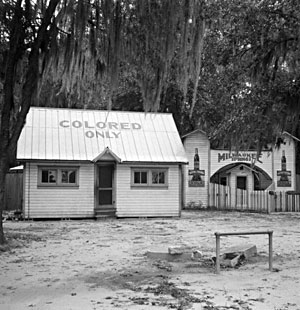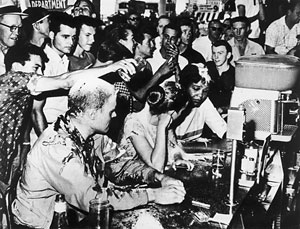




Advanced Search
Dress Up | 1st Person | African American Map | Now Read This | Magic Lens | Tool Videos | Architecture | e-Postcards | Chronologies
Juanita Nelson - 1939-1943: Civil rights actions as a teenager and young adultIt was in 1896 that the United States Supreme Court decided it was legal to have separate public facilities and services for white people and black people, as long as those services and facilities were of equal quality. The ‘separate but equal’ law remained in effect until 1954 when the Supreme Court ruled that, with regard to education, separate schools for black children and white children were not, and could never be, truly equal. It would not be until the late 1960s that the United States Supreme Court would rule that segregation by law was unconstitutional. In 1938, seventeen years before the Supreme Court determined that the states would have to integrate schools, 16-year-old Juanita Nelson publicly expressed her belief that segregation is just not fair… Learn more about Juanita Nelson: View a timeline of her life and listen to her full interview. Stories by this speaker

This photograph documents one example of "Colored Only" accommodations. The building stood at the entrance to Milwaukee Springs, a health and recreation property for African American servicemen. Juanita Nelson describes Jim Crow railroad cars in her interview. "This was a time," she remembers, "when all people who had darker–;colored skin, or part dark African ancestry, were seated in a particular place and could not go anywhere else–;in streetcars and so forth. In the South particularly they had fountains that said, "whites," "colored," all that sort of thing. It was a very much division in talking about races, which I don't like. I think there's one race anyway, as far as I'm concerned." Segregation, or the legal separation of people based on skin color, had an effect on many aspects of daily life. Not only were there "whites only" and "colored only" water fountains and bus seats, but segregation determined where one could shop, eat, drink, swim, learn, pray, spend the night, and be entertained. Photograph c. 1940 by Charles Foster. Courtesy of State Archives of Florida. 
This image captures civil rights activists being assaulted by a crowd during a Jackson, Mississippi, lunch counter sit-in on May 28, 1963. Twenty years earlier, Juanita Nelson and her friends were arrested after refusing to pay 25 cents for a 10-cent cup of hot chocolate at a "whites only" drug store lunch counter in Washington D. C. Photograph by Fred Blackwell for the Associated Press and the Jackson Daily News. Wisconsin Historical Society, Image ID #9999004618. 
President Lyndon Johnson confronts Georgia Senator Richard Russell on December 17, 1963. Senator Russell who led the "Southern Bloc" of senators opposed to the passage of the civil rights bill, asserted, "We will resist to the bitter end any measure or any movement which would have a tendency to bring about social equality and intermingling and amalgamation of the races in our [Southern] states." The Civil Rights Act of 1964 was signed into law on July 2. In a speech broadcast to the nation on radio and television, President Johnson stated: The purpose of the law is simple. Photographed by Yoichi R. Okamato. Courtesy of the Lyndon Baines Johnson Library and Museum. Story Clip #1:1939—Juanita at 16—On board a segregated train headed for Georgia Wait for each file to download, then click the arrow to play the audio. I was sixteen years old and I went with my mother to visit her parents in Georgia, and that's where I guess I did my very first action because our train was late for changing in Cincinnati and we were rushed into a car. By the time we got settled, I recalled, I looked around and saw that we were in a Jim Crow car. Now I'd heard of these things, and I knew about that sort of thing. Q: Would you explain what a Jim Crow car is, for people who don't know? This was a time when all people who had darker–colored skin, or part dark African ancestry, were seated in a particular place and could not go anywhere else—in streetcars and so forth. In the South particularly they had fountains that said, "whites," "colored," all that sort of thing. It was a very much division in talking about races, which I don't like. I think there's one race anyway, as far as I'm concerned. So I asked my mother if we can change cars and she said, "Oh Nita I'm just tired." And I think that was true. And I sat and fumed, and finally I got up and sat in every car in that train because I was so upset, and my recollection–this was a long time ago, of course–is that nobody bothered me except the porter, and he was afraid that something would happen to me because he had the same color skin that I had. Then I went back and sat by my Mother and I felt better because I had expressed myself. Story Clip #2:"You know who you are": Juanita receives advice from her mother I guess I remember very well, when I was, I think it was in junior high school, somebody called me "nigger." And I went home, crying, or anyway, very disconsolate. My mother said, "Why are you worrying about...you know who you are." So...[laugh] I've always appreciated that. Story Clip #3:1943—Action at a drug store lunch counter while attending Howard University And so I did go to Howard University, and that was where I was arrested for the first time. I went with two of my friends who were undergrad coeds, downtown in Washington, DC, which was about as segregated as anyplace in the United States at that time. I went to Howard in 1941. This was in '43 though, at the beginning of the year, I think. And we went to a drugstore that had a lunch counter...asked for some hot chocolate. We were told, "We don't serve Negroes." We said, "Well, we'd like to see the manager." "The manager isn't in." And we said, "Well, we have plenty of time, we'll just sit here." And finally they brought the hot chocolate, but they gave us tickets... bills for 25 cents, when it clearly stated on the board that hot chocolate was ten cents a cup, so that's what we put down. And I always like to say that's probably all we had anyway. But, then we walked out and were met by ... my recollection is ... seven of DC's finest ñ that is, the police. And they put us in the paddy wagon and took us to jail. At that time, I guess we were sort of hyped up. We thought this was a great lark: real life! We'll get to eat with the real convicts, and so forth and so on. But the Dean of Women came and got us out before suppertime. And I always say that that saved me from ever eating in jail. I've been in jail a few times since then, and I've never eaten when I was in jail, but I would have eaten that time, [chuckle] and I'm sure the food wouldn't have been very good anyway. Story Clip #4:Howard's Civil Rights Committee desegregates a greasy spoon restaurant and Juanita explains the meanings of the terms 'opening' Then I had been involved in CORE [Congress of Racial Equality]. I was also involved when I was at Howard; I'd forgotten about that. After we had this incident that I was talking about, of trying to get the hot chocolate, a woman who became a very dear friend, Polly Murray, was there. She was about ten years older than us coeds. She was in law school, and she knew about CORE that had started. And we formed the Howard's I think it was called "Civil Rights Committee" and actually opened up a restaurant on the edge of campus, in one week, less than a week. I never had such a quick victory, [chuckle] never since that time. It was just a sort of a greasy spoon restaurant, but it was a heady victory for us. We had a picket line; we had a sit–in; lots of people agreed with us, and he capitulated. Q: So, when you say you "opened up a restaurant..." I mean we desegregated it, it was open to ... I always forget that; people don't know exactly what I mean. And so that was very good. So that happened before I left. I sometimes regretted having left Howard because they did some bus testing. Because you know, DC is surrounded ñ Virginia, Maryland and so forth, and they were all, of course, very segregated too. Q: Will you explain the concept of "testing"? You try to do something; like for instance, if blacks were supposed to sit from the back, you would just go and get your ticket and sit in the front and see what happened. Most often, you'd just be arrested or that sort of thing. Related ResourcesThe following source file was not found: ebdav/centuries/html/resource/nelson1939.html
|
| |
Home | Online
Collection | Things To Do | Turns
Exhibit | Classroom | Chronologies | My
Collection
About This Site | Site
Index | Site Search | Feedback